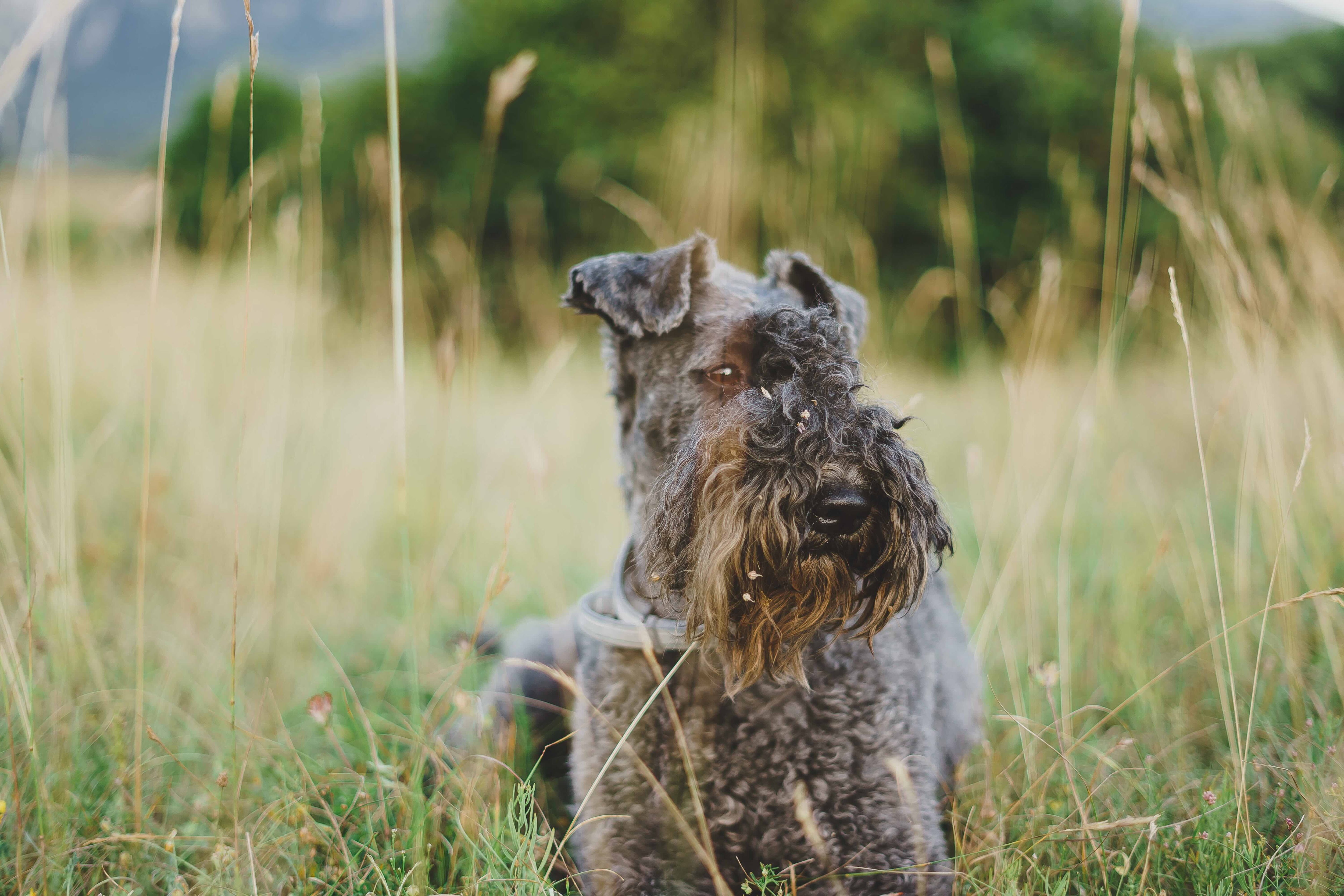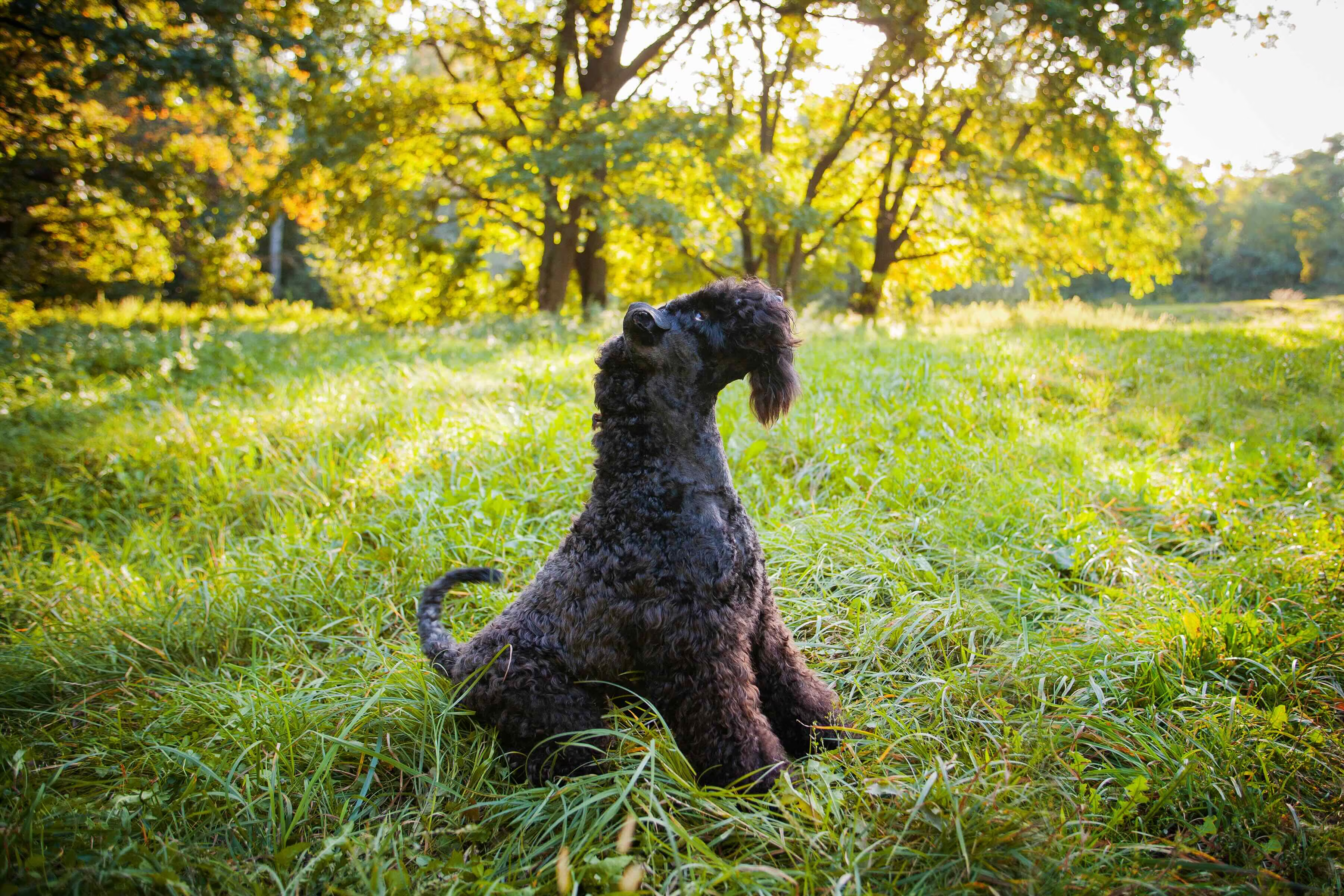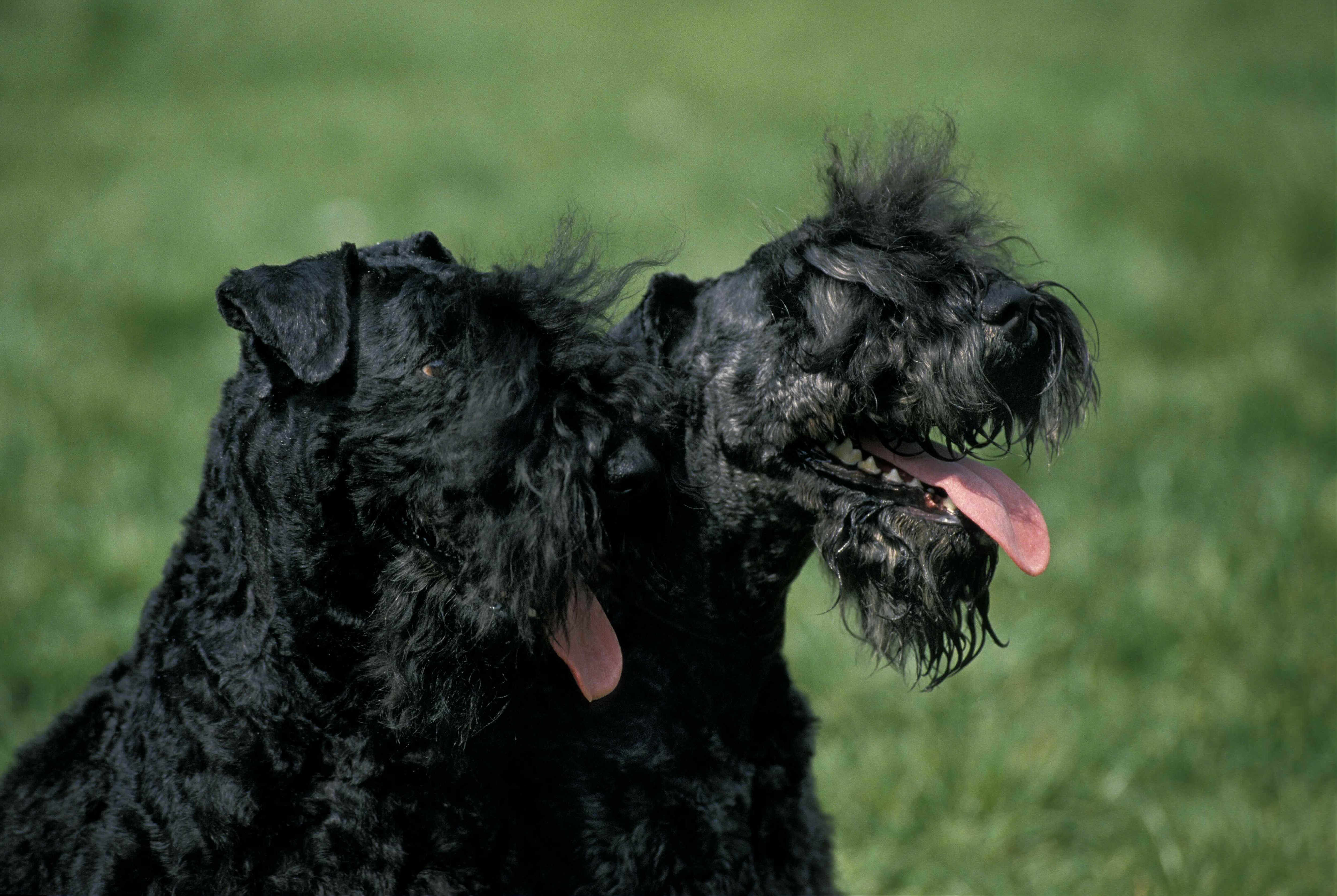Kerry Blue Terrier
Adobe Stock/savytska
Kerry Blue Terriers are extremely affectionate dogs recognized for their soft, striking blue-gray coat. This coat (which can also be black or silver) doesn’t shed a lot, so Kerry Blues can be a good fit for some people with allergies, even though there’s no such thing as a 100% hypoallergenic dog.
The specific origin of this terrier breed is unclear, according to the United States Kerry Blue Terrier Club (USKBTC), but the dogs worked as farm dogs for decades and take their name after the county Kerry in Ireland.
Caring for a Kerry Blue Terrier
The Kerry Blue Terrier is an intelligent dog that’s eager to please their pet parents. This combination can make training go smoothly, especially when positive reinforcement techniques are used. But the Kerry Blue’s smarts—and their high-energy nature—also mean these dogs need mental stimulation to stay out of trouble.
A Kerry Blue Terrier’s temperament is affectionate toward their family and, when properly introduced, patient with children. However, they may be more reserved around strangers and other animals—including dogs—especially if a puppy hasn’t been properly socialized.
Because Kerry Blues do not shed their coat, they must be brushed at least once a week to prevent matting.
Kerry Blue Terrier Health Issues

While the Kerry Blue Terrier is a generally healthy dog, there are some significant conditions pet parents should know about.
In addition to these conditions, all dogs are at risk of injury and illness. Purchasing pet insurance for your dog may help pay for any expensive medical needs that arise.
Skin Issues
Kerry Blue Terriers are prone to an assortment of skin issues, including:
-
Skin allergies that cause itchiness and may lead to hot spots
-
Lumps and bumps. (Many of these may be non-cancerous cysts, but every new bump should be evaluated by a veterinarian.)
-
Corns on their foot pads
-
A dry, cracked nose
Contact your veterinarian if you notice changes in your dog’s skin or if they suddenly become itchier than normal.
Hip Dysplasia
Hip dysplasia is a genetic disease characterized by a loose hip joint that causes the cartilage and bone to wear down. This can cause osteoarthritis, which leads to pain, limping, and difficulty rising.
Many vets recommend low-intensity exercise and joint supplements containing omega-3 fatty acids, glucosamine, and chondroitin for dogs diagnosed with hip dysplasia. When pain is present, non-steroidal anti-inflammatory drugs (NSAIDs) may be prescribed to reduce inflammation and pain. Your vet may recommend surgery in severe cases.
Keratoconjunctivitis sicca (Dry Eye)
Keratoconjunctivitis sicca (KCS), commonly called dry eye, occurs when a dog’s eyes do not produce enough tears. This lack of lubrication causes the surface of the eye and the inside of the eyelid to rub against each other, leading to inflammation. A thick mucus may also develop instead of normal tears.
Most dogs with dry eye will have painful, red eyes, which can lead to squinting or rubbing the eye. Ulcers on the cornea are common with dry eye and require immediate treatment. Dry eye is treated with topical eye medication.
von Willebrand Disease
Von Willebrand disease (vWD) is a genetic blood disorder that’s seen in Kerry Blue Terriers more than some other dog breeds.
This disease causes a deficiency in a protein called the von Willebrand factor, which is necessary for platelets to stick together and form a clot. In dogs with vWD, the blood may have difficulty clotting, which can lead to bleeding from the nose, vulva, bladder, or gums. Affected dogs may also bleed for a long time after trauma or surgery.
Many vets recommend testing for vWD prior to any planned surgery, including spays and neuters.
Dental Disease
Dental disease is one of the most common conditions seen in dogs as they grow older. Bacterial tartar and plaque lead to inflammation of the tissues around the teeth, and eventually to tooth and bone decay. Dental disease is a painful condition that may even affect the health of internal organs.
The best way to prevent dental disease is with daily toothbrushing with a dog-specific toothpaste. Some diets, treats, dental chews, and chew toys also help to prevent plaque and tartar—but these aren’t a substitute for brushing your dog’s teeth.
Routine dental cleanings done by a veterinarian are recommended to remove plaque and tartar, polish teeth, and treat or extract teeth that are significantly unhealthy.
What To Feed a Kerry Blue Terrier
Feeding your Kerry Blue Terrier a commercial kibble or wet food that’s compliant with the recommendations of the Association of American Feed Control Officials (AAFCO) is a good way to ensure they receive a complete and balanced diet.
Kerry Blue Terrier puppies should be fed a diet formulated specifically for puppies or designated for all life stages. Your vet may recommend a dental-focused diet for adult dogs to help prevent dental disease.
Talk to your veterinarian about whether and when your Kerry Blue needs to transition to a senior dog food.
How To Feed a Kerry Blue Terrier
An adult Kerry Blue does best with two measured feedings per day. Kerry Blue Terrier puppies should eat three to four small meals per day, on a regular schedule, to help maintain stable blood sugar and prevent hypoglycemia. The USKBTC recommends sticking to this three-meals-per-day schedule until your puppy is about 6 months old.
How Much Should You Feed a Kerry Blue Terrier?
The recommended caloric intake for a Kerry Blue Terrier depends on your pup’s size, metabolism, neuter status, health, and activity level.
The feeding guide labels on dog food packaging provide valuable information for pet parents regarding portion sizes. But the best way to determine how much to feed your dog is by talking to your veterinarian, who can calculate specific caloric needs.
Nutritional Tips for Kerry Blue Terriers
Kerry Blue Terrier dogs require a balance of carbohydrates, proteins, and fats to stay healthy and lean. As long as they eat an AAFCO-approved food, all their nutritional needs will be met.
However, Kerry Blues may benefit from the addition of omega-3 fatty acids into their diet. Omega-3 fatty acids can be found in skin and joint supplements, fish oil, and even in some specially formulated dog foods. These fatty acids act as natural anti-inflammatories that support the breed’s skin, coat, kidneys, joints, and heart.
Behavior and Training Tips for Kerry Blue Terriers
Kerry Blue Terrier Personality and Temperament

The Kerry Blue Terrier is a smart and affectionate breed that will attach closely to their family, according to the breed club. They enjoy hiking, dock diving, and agility. They have a lot of energy and want to play all the time, so they’re the best fit for an active and outdoorsy family.
When properly introduced to children, most Kerry Blue Terriers are patient with kids. They can be wary of other dogs if not introduced at a young age, so make sure introductions are always done slowly and positively.
Kerry Blue Terrier Behavior
Understanding a Kerry Blue Terrier’s behavior requires understanding their history. This Irish dog breed was historically bred to work on farms as a ratter, retriever, and herder. These behaviors can carry over into pet Kerry Blues today.
Kerry Blue Terriers may be tempted to chase smaller animals, like neighborhood squirrels or cats. Because of this, always keep your dog within a securely fenced space or on a leash whenever they’re outside.
They may also bark to excess, especially if they’re not receiving enough mental stimulation or exercise (they need about one hour of exercise every day). Training can help reduce barking, but you shouldn’t expect a Kerry Blue to be a quiet companion.
Kerry Blue Terrier Training
They are very smart and desire to please their pet parent, so training is usually not as difficult as it is with some other breeds. These playful dogs learn best with training games and positive reinforcement methods.
Begin socializing your Kerry Blue Terrier puppy as soon as you bring them home, and ask your breeder how they have approached socialization. It’s vital to expose dogs to new people, animals, sounds, smells, and situations early in life so they are comfortable in new settings.
Fun Activities for Kerry Blue Terriers
-
Agility
-
Dock diving
-
Obedience training
-
Fetching
-
Herding
Kerry Blue Terrier Grooming Guide

While there are some silver and black Kerry Blue Terriers, most dogs have the breed’s characteristic blue-gray coat. No matter the color, all Kerry Blues are soft to the touch thanks to their medium-length, wavy coat.
They do not shed heavily, but Kerry Blue Terriers do require weekly brushing at home and routine professional grooming about every six weeks to trim their coat and beard.
Skin Care
Despite their sensitive skin, Kerry Blue Terriers do not have special skin care needs other than close monitoring. They do best when bathed about once a month with a gentle conditioning shampoo.
Contact your veterinarian if you notice changes in your dog’s skin.
Coat Care
A Kerry Blue Terrier’s coat should be brushed at least weekly. Using conditioning sprays may make brushing easier. Professional grooming is recommended about every six weeks to trim the coat and shape the Kerry Blue’s beard.
An ungroomed Kerry Blue Terrier will develop mats, which can lead to skin infections.
Eye Care
Kerry Blue Terriers do not have special eye care grooming requirements. If debris collects in the corner of their eyes, this can be gently wiped off with a damp cloth. Visit the vet if you notice changes in your dog’s eyes, such as squinting, discharge, or redness.
Ear Care
To prevent ear infections, clean your dog’s ears every two to four weeks (and anytime your Kerry Blue is in water, including after baths) with a vet-approved ear cleaner. Keeping the ear hairs trimmed (not plucked) can also help reduce ear infections.
If redness, odor, or debris is noted, an infection may be present. Consult your veterinarian.
Considerations for Pet Parents

Kerry Blue Terriers make wonderful pets for families who can keep up with their grooming requirements and exercise needs. Because they are extremely intelligent and eager to please, Kerry Blues can be easy (and fun!) to train with treats and praise.
Their intelligence also means they require a lot of mental stimulation via activities like scent walks, puzzle toys, and training. When socialized early in life and introduced appropriately, Kerry Blue Terriers are gentle with children and pets.
Kerry Blue Terrier FAQs
Are Kerry Blue Terriers good pets?
Kerry Blue Terriers are good pets for active families and are very affectionate with those they love. When properly introduced and socialized, most Kerry Blues do well with other dogs and children.
Do Kerry Blue Terriers bark a lot?
Yes, Kerry Blues have a history as farm dogs and may bark to excess in some situations. However, all dogs are individuals, and some may be quieter than others.
Can Kerry Blue Terriers be left alone?
Kerry Blue Terriers can be OK when left alone for a short time, especially if they’ve been crate trained. However, this is a social breed that may develop separation anxiety if left alone for long periods with nothing to do.
Are Kerry Blue Terriers hyper?
Like most terriers, Kerry Blues can have a lot of energy. They are spunky, energetic, need a lot of physical and mental activity, and can be hard to exhaust.
